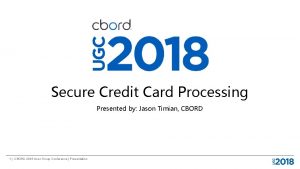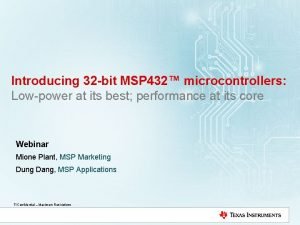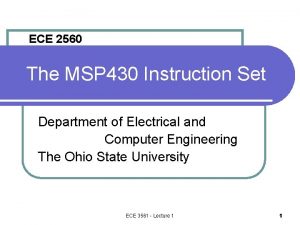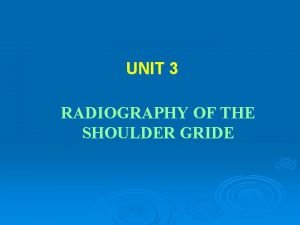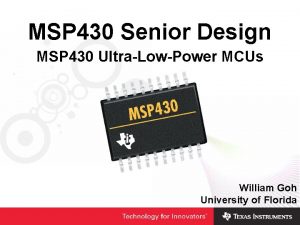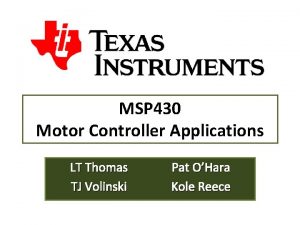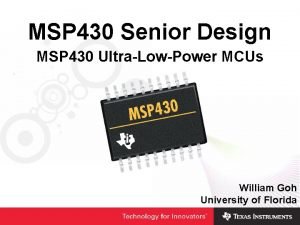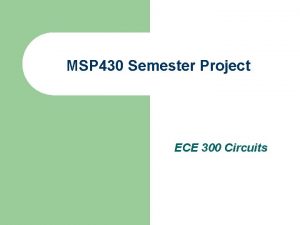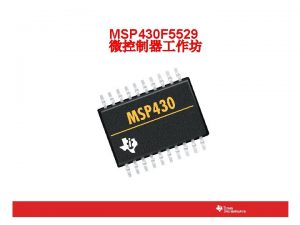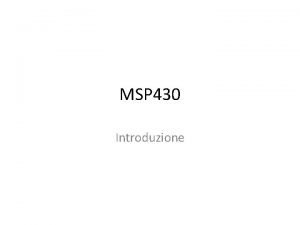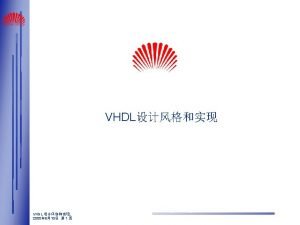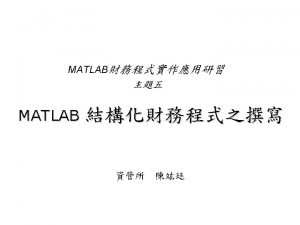MSP with Cap TIvate Technology Cap TIvate Signal
































- Slides: 32

MSP with Cap. TIvate™ Technology Cap. TIvate Signal Conditioning Overview: Tuning the Conversion Gain and Conversion Count Parameters May 2016 1

Cap. TIvate Signal Conditioning Overview The Cap. TIvate peripheral, available on certain MSP microcontrollers, contains several unique features for controlling the resolution, sensitivity, and dynamic range of capacitive measurements. These features enable sensing solutions that are highly optimized for a wide variety of design careabouts, such as ultra low power, high sensitivity for thicker overlays, and large parasitic capacitances. The Cap. TIvate peripheral features are controlled by setting tuning values in the Cap. TIvate Design Center and Cap. TIvate Software Library. This training session will discuss how the peripheral features work, and how to tune them for different applications! 2

Topics I. Cap. TIvate Charge Transfer II. Signal Conditioning: Gain Stage III. Signal Conditioning: Offset Subtraction Stage IV. Runtime Calibration Algorithm 3

Cap. TIvate Charge Transfer How do we measure changes in capacitance? 4

Cap. TIvate Charge Transfer How do we measure changes in capacitance? Variable Measured Fixed 5

Cap. TIvate Charge Transfer Vreg Electrode Voltage How do we measure changes in capacitance? Vtrip Integration Capacitor Voltage 6

Cap. TIvate Charge Transfer Vreg Electrode Voltage How do we measure changes in capacitance? Vtrip Integration Capacitor Voltage 7

Cap. TIvate Charge Transfer Vreg Electrode Voltage How do we measure changes in capacitance? 1 Vtrip Integration Capacitor Voltage 8

Cap. TIvate Charge Transfer Vreg Electrode Voltage How do we measure changes in capacitance? 1 Vtrip Integration Capacitor Voltage 9

Cap. TIvate Charge Transfer Vreg Electrode Voltage How do we measure changes in capacitance? 1 2 Vtrip Integration Capacitor Voltage 10

Cap. TIvate Charge Transfer Vreg Electrode Voltage How do we measure changes in capacitance? 1 2 Vtrip Integration Capacitor Voltage 11

Cap. TIvate Charge Transfer Vreg Electrode Voltage How do we measure changes in capacitance? 1 2 Vtrip Integration Capacitor Voltage 12

Cap. TIvate Charge Transfer Vreg Electrode Voltage How do we measure changes in capacitance? 1 2 Vtrip 3 Integration Capacitor Voltage 13

Cap. TIvate Charge Transfer Vreg Electrode Voltage How do we measure changes in capacitance? 1 2 Vtrip 3 Integration Capacitor Voltage 14

Cap. TIvate Charge Transfer How do we measure changes in capacitance? When a user touches near the electrode, they present an additional capacitance to the network being measured. This increase causes the total number of charge transfers required to “fill” the integration capacitor to decrease! This decrease in total number of charge transfers occurs because more charge is moved over during each transfer phase, filling up the integration capacitor more quickly. The Cap. TIvate Software Library analyzes the number of charge transfers that were required to fill the integration capacitor to determine if a user is present or not. 15

Cap. TIvate Charge Transfer There a few problems with this method in and of itself: 1. The input capacitance range of the system is restricted by the size of the integration capacitor. 2. There is no control over measurement resolution. 3. A user’s change may only make up a small percentage of the overall electrode capacitance during a touch, making the change in capacitance due to a touch very difficult to detect. Solution: Gain and offset subtraction signal conditioning! 16

Topics I. Cap. TIvate Charge Transfer II. Signal Conditioning: Gain Stage III. Signal Conditioning: Offset Subtraction Stage IV. Runtime Calibration Algorithm 17

Signal Conditioning: Gain Stage The gain stage provides the ability to scale the size of the electrode capacitance as it appears to the integration capacitor. The charge associated with the input capacitance x is multiplied by the gain ratio G to produce the amount of charge y that is actually transferred to the integration capacitor. This allows for a fixed size integration capacitor to be used on-chip, as the input capacitance is scaled with respect to it to control the measurement resolution. 18

Signal Conditioning: Gain Stage Let’s look at an example case, in which there is: - A 20 p. F approximate electrode capacitance (varies with PCB layout and nearby conductors) - A 1 p. F effective touch capacitance (varies with overlay thickness, electrode size, and the user) - A 80 p. F integration capacitor (on-chip, fixed-size) With a 1: 1 ratio (no gain): With a 24: 1 ratio: With a 240: 1 ratio: No-touch result: 4 Touched result: 4 Delta: 0 No-touch result: 96 Touched result: 92 Delta: 4 No-touch result: 960 Touched result: 920 Delta: 40 Not enough resolution to detect a touch Some resolution to detect a touch Enough resolution to detect a touch 19

Signal Conditioning: Gain Stage Note that this example is for illustration only. In a real system, the integration capacitor trips at a different voltage (1. 0 V) than the voltage being applied to the electrode (1. 5 V), and there is some amount of tolerance to the size of the integration capacitor. The important thing is that these factors invisible to the designer and the application, since the gain may be calibrated for each element to achieve the desired measurement resolution, regardless of minor variations in the system. In addition, the system may be recalibrated at runtime to maintain the desired sensitivity even when exposed to temperature and humidity variations. 20

Signal Conditioning: Gain Stage Cap. TIvate contains a coarse gain setting and a fine gain setting, allowing for precise control over measurement resolution. 900 Idle Touched 800 700 Result 600 500 400 300 200 100 0 Coarse and Fine Gain Sweep There are 8 coarse gain steps and 20 fine gain steps, for a total of 160 settings. 21

Signal Conditioning: Gain Stage The 160 settings allow for the 10 mm self capacitance buttons on the CAPTIVATE-BSWP panel to be configured with this input range: - 9 to 892 charge transfers when idle - 9 to 845 charge transfers when touched - 0 to 47 counts of delta due to a touch This range represents the application of the lowest transfer ratio setting out to the highest transfer ratio setting in the self capacitance measurement mode. NOTE: For the proximity sensor on the CAPTIVATE-BSWP panel, the range is 8 -331 charge transfers when idle. This is due to the larger parasitic capacitance of that sensor. 22

Signal Conditioning: Gain Stage By adding the gain stage in the signal conditioning block, we’ve provided a way to accept a wide variety of input capacitances and control our measurement resolution accordingly. There’s still one problem, however! Even at the highest ratio, the delta due to a touch for this button is only 47, deviating down from the untouched result of 892. This works out to about a 5. 3% change. This is quite consistent with our example application in which we had 20 p. F of base capacitance and 1 p. F of touch capacitance (changing the system by 5%). However, we might want more than 47 counts of delta for a slider, wheel, or proximity sensing application. To solve this problem, we need the second stage in the signal conditioning block: the offset subtraction stage. 23

Topics I. Cap. TIvate Charge Transfer II. Signal Conditioning: Gain Stage III. Signal Conditioning: Offset Subtraction Stage IV. Runtime Calibration Algorithm 24

Signal Conditioning: Offset Subtraction Stage A challenge with capacitive sensing is overcoming the large difference in magnitude between an electrode’s inherent base capacitance and the capacitance change associated with a touch or proximity event. The touch capacitance (quantity of interest) is often 10 -100 times smaller than the base parasitic capacitance of the sensing electrode itself to earth and circuit ground. 25

Signal Conditioning: Offset Subtraction Stage As a result, the measurement time becomes very large because the base parasitic capacitance must be measured along with the touch capacitance. In our earlier example of a 20 p. F electrode with a 1 p. F touch, only a 5% change is capacitance is created due to a touch. What is needed is a way to compensate out the large base capacitance, so that the addition of a touch creates a larger percent change in capacitance. For example, if 10 p. F of the 20 p. F base capacitance is compensated for, then a 1 p. F change is now a 10% change in the overall measurement. 26

Signal Conditioning: Offset Subtraction Stage The offset subtraction stage provides the ability to subtract a fixed amount of charge during each charge transfer, reducing the effect of the base parasitic capacitance. The charge associated with the input capacitance x is multiplied by the gain ratio G (as discussed previously). Then a fixed amount S is subtracted off and not brought over into the integration capacitor. This allows for a portion of the “DC” charge associated with an electrode’s parasitic capacitance to be subtracted out, increasing sensitivity to changes in capacitance. 27

Signal Conditioning: Offset Subtraction Stage Integrated ↑ Subtracted Off → 28

Signal Conditioning: Offset Subtraction Stage Result Since charge is removed each time a charge transfer step is performed, the total number of charge transfers required to “fill” the integration capacitor will increase as the amount of offset subtraction applied increases. This is because less charge is moved over each time! 1000 900 800 700 600 500 400 300 200 100 0 Idle Touched Offset Sweep 29

Signal Conditioning: Offset Subtraction Stage Result This results in an increase in the delta due to a touch as offset subtraction is added! 500 450 400 350 300 250 200 150 100 50 0 Delta Offset Sweep 30

Topics I. Cap. TIvate Charge Transfer II. Signal Conditioning: Gain Stage III. Signal Conditioning: Offset Subtraction Stage IV. Runtime Calibration Algorithm 31

Runtime Calibration Algorithm As a designer, you don’t need to select the coarse gain, fine gain, and offset subtraction tap at all! This would be very time consuming because it would need to be done for every electrode individually. Instead, the Cap. TIvate Software Library contains a runtime calibration algorithm that will automatically tune these parameters based on common inputs for all of the elements within the sensor. Conversion Count → Conversion Gain → Runtime Calibration Algorithm CAPT_calibrate. Sensor() CAPT_calibrate. Sensor. With. EMC() → Coarse Gain [ ] → Fine Gain [ ] → Offset Tap [ ] 32
 Handicapresultat
Handicapresultat Cap compas cap vrai
Cap compas cap vrai Baseband signal and bandpass signal
Baseband signal and bandpass signal Digital signal as a composite analog signal
Digital signal as a composite analog signal The product of two odd signals is
The product of two odd signals is Baseband signal and bandpass signal
Baseband signal and bandpass signal Primer pravilnika o računovodstvu za mikro pravna lica
Primer pravilnika o računovodstvu za mikro pravna lica Msp ichat
Msp ichat Izgradnja i opremanje proizvodnih kapaciteta
Izgradnja i opremanje proizvodnih kapaciteta Freedom pay credit card processing
Freedom pay credit card processing Moviestarplanet online
Moviestarplanet online Msp 32
Msp 32 Msp 430
Msp 430 Organigramme d'un hopital public au maroc
Organigramme d'un hopital public au maroc Gride msp
Gride msp Msp burnout
Msp burnout Msp vms best practices
Msp vms best practices Prva primena msfi za msp
Prva primena msfi za msp Msp uga
Msp uga Msp test
Msp test Msp project
Msp project Msp gift card
Msp gift card Msp nr 2 knurów
Msp nr 2 knurów Bitdefender cloud storage
Bitdefender cloud storage Msp definice
Msp definice Msp430 risc cpu architecture
Msp430 risc cpu architecture Msp radar
Msp radar Msp master service agreement
Msp master service agreement Datapol msp
Datapol msp Pega platform (pegacloud.net)
Pega platform (pegacloud.net) Kfv mecklenburgische seenplatte
Kfv mecklenburgische seenplatte Ms build
Ms build Msp in a group motor application
Msp in a group motor application









